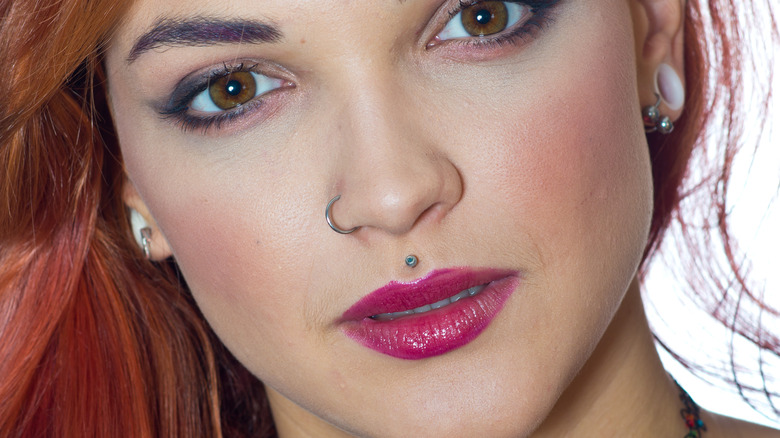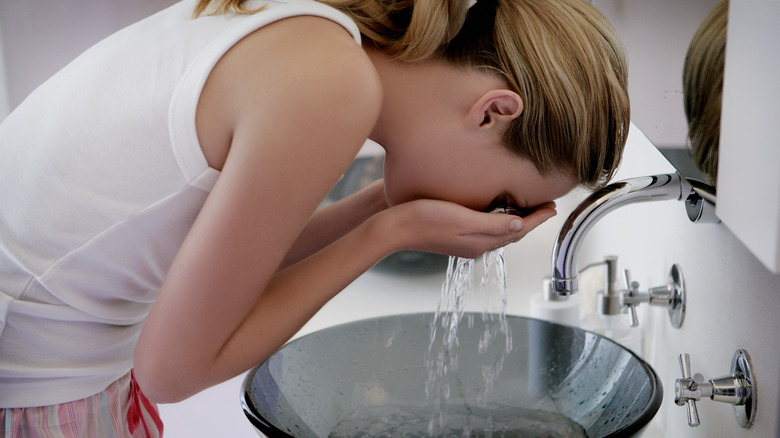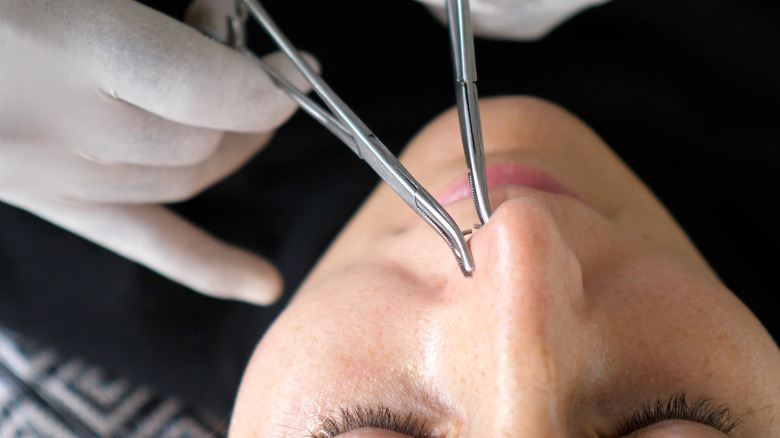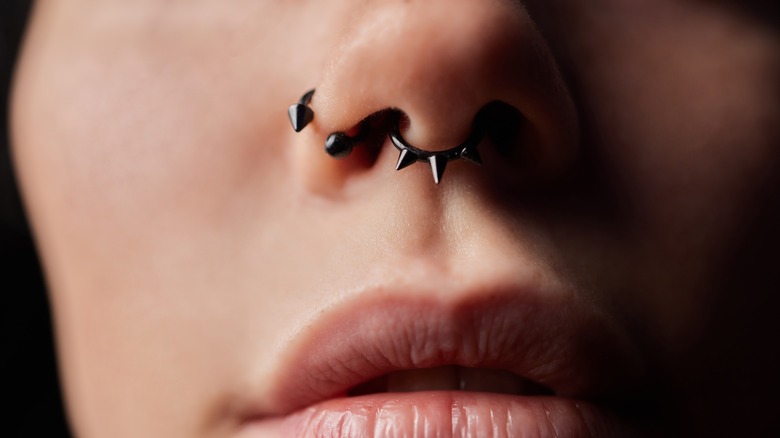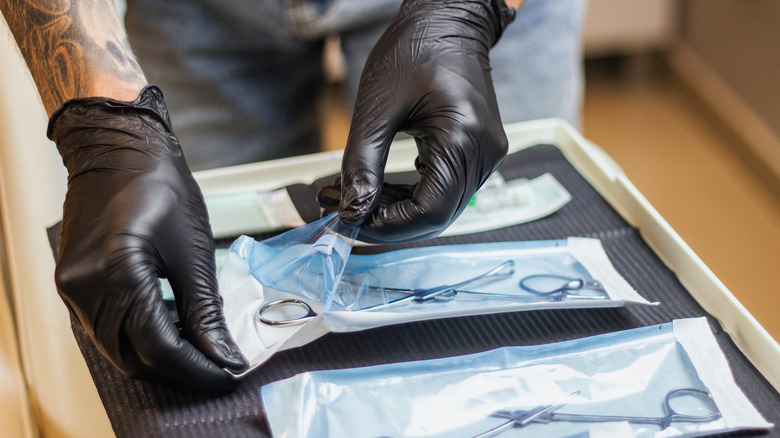Medusa Piercings: What To Expect
Professionally referred to as the philtrum piercing, the medusa piercing sits between your lips and your nose — directly above your cupid's bow. According to tattoo and body piercing aftercare brand H2Ocean, this particular piercing should always be done by an expert, as it's considered both a body and oral piercing in one. In other words, if anything goes wrong, there may be serious consequences that can affect your face, teeth, mouth, and gums.
The medusa piercing is always a stud made of up three parts: the bead (the stud), the disk (the back), and the barbell (the bar that connects the bead and the disk). The piercing will be made using a thin, hollow needle before the piercer places the jewelry.
There are two types of medusa piercings you should know about
If you are looking to get a medusa piercing, or any other type of piercing, it is always important to do your research beforehand about what type you want and where. For medusa piercings, there are two different variations to choose from. According to Pierced, there is the double and the vertical.
The double piercing is just what it sounds like, where the philtrum is pierced twice beneath the septum. If you are looking for a daintier style with studs on top of one another, this piercing look is the way to go. According to Fresh Trends, it's recommended to perform the two piercings one at a time to reduce the pain and ensure an easier healing experience.
The vertical variation is two piercings one on top of the other. Although it looks like there are two different holes in the vertical piercing, there really is only one. The choice of piercing style should be based on your personal preference, pain tolerance, and what you are looking to spend.
However, not everyone can get a medusa piercing. The age requirement may be based on the studio you attend, but typically you must be at least 18 years old (via Medusa Body Piercing). According to Fresh Trends, if you are susceptible to receding gums or have other oral issues, this might not be the best piercing for you.
What are the risks of getting a medusa piercing?
Just like any piercing or tattoo, there are risks and side effects to consider before scheduling an appointment for a medusa piercing. Like most piercings, infections are common if it is not cared for properly. According to Medical News Today, some risks and side effects include discoloration around the area of the piercing, blood coming out of the wound, and feeling very ill afterward, whether that involves a fever or body aches. Additionally, if the piercing area feels swollen or hot, it's a good idea to visit a medical professional to check for any type of infection.
Unlike other piercings, medusa piercings affect both your face and mouth, meaning you will have to change some of your habits during the healing period, such as cutting back on smoking, alcohol, and anything else you ingest that may cause harm or irritation, per Canadian piercing studio Pierced. Typically, after receiving the medusa piercing, people should avoid kissing or oral sex for at least two weeks.
Even if everything is done correctly after getting the piercing, side effects are still common. According to Fresh Trends, piercing rejection can also occur, which is when the body has an adverse reaction to the presence of the jewelry. Additionally, piercing bumps can occur due to irritation.
What to expect during your piercing appointment
It's always good to come prepared for a medusa piercing appointment. For starters, be sure to take care of your teeth by cleaning out bacteria and flossing.
Pain is typically the first thing that comes to mind when getting a new piercing. Pain tolerance will differ from person to person. Those who frequently get piercings or tattoos may be more accustomed to that level of discomfort. Pierced reported that many guests claimed to feel a sharp pain when the needle first poked the tissue, but otherwise the process is similar to any other piercing. If this is your first piercing ever, know that it will most likely hurt only for a few seconds.
Similar to other piercings, the piercer will clean their tools beforehand. According to Healthline, the piercer will also clean the piercing area, and you are required to rinse your mouth with an alcohol-free mouthwash. Next, they will find the best placement for the piercing and mark it. The piercer will then clamp the tissue and move it away from the rest of your mouth, insert a needle from the outside, remove the forceps, and push the needle through with a taper pin. After that, they will place a pin into the jewelry and push it into the piercing, remove the pin, and clean up the area.
What to expect after getting a medusa piercing
For a few days after getting a medusa piercing, you will most likely experience some pain. Aftercare is incredibly important to ensure a healthy healing process and avoid any sort of infection. According to Pierced, it is very normal to experience some throbbing and pain around the area of the hole. Additionally, it is important to keep the stud intact while the mouth is healing. For the first two weeks, be careful whenever you eat or drink to make sure no food gets stuck inside and that the piercing doesn't get irritated.
When it comes to cleaning a medusa piercing, be sure to clean both the inside and the outside. For the outside, Pierced recommends irrigating the piercing with sterile saline and cleaning it with mild, alcohol- and scent-free soap. For the inside, rinse after every meal with non-alcoholic mouthwash and use a new toothbrush after the procedure. Otherwise, keep the philtrum clean as normal for the first six to 12 weeks.
How long does it take for a medusa piercing to heal?
Depending on what type of piercing you get, there are different healing times. For a medusa piercing, it will take between eight and 12 weeks to fully heal depending on how well you take care of it, according to Healthline.
There are many steps to properly caring for your piercing. This includes washing your hands before cleaning it, using a sterile saline solution at least twice a day, using a new toothbrush as needed, keeping your toothbrush clean, and practicing oral hygiene. It is recommended that you stick to soft foods (nothing too spicy or hot) to help reduce swelling, and also avoid alcohol or smoking.
Now that you know how to take care of your new piercing, there are some things you should avoid completely. First, avoid chewing anything that could create bacteria in the area of your piercing, like gum, or putting your fingers in your mouth. Avoid kissing and oral sex, and don't share cups or utensils with other people. Fresh Trends recommends that you watch out for any swelling, refrain from touching your jewelry often, keep the piercing as dry as possible, avoid using makeup on and around the piercing, and be careful while brushing your teeth.
How much will a medusa piercing cost?
Before booking your session, it is important to know that the price of a medusa piercing may vary depending on where you get it done. According to Pierced, the price can range from $40 to $80, with an additional cost for the jewelry selected. Be cautious of studios offering too low of a price for this piercing, as it can possibly increase the risk of infection if it's not done properly or with the right tools. Since this piercing is performed near a location that is prone to bacteria, you don't want to pay for a session that is not performed by a professional (via Fresh Trends).
Take some time to research some of the best piercing providers in your area to get an idea of how much you can expect to spend on the session, verify that the studio looks clean, and confirm the experience and qualifications of the piercer.
Will a medusa piercing hurt your teeth?
The million-dollar question is: Do medusa piercings hurt your teeth? The short answer is, it is possible. According to Medical News Today, any oral piercings, especially a medusa piercing, could potentially damage your gums or teeth and cause oral infections.
The healthier you are overall, the faster the healing process will be, so it is critical to keep these piercings clean. According to Medusa Body Piercing, you should floss daily and brush your tongue and jewelry. Brush gently with a soft-bristled toothbrush, and store it separately from other toothbrushes to avoid spreading bacteria. You can use mouthwash to freshen up as long as it does not have any alcohol in it, as this may cause irritation of the piercing (via Fresh Trends). Another option is to swish with a mixture of salt and water to keep the area clean and soothe any discomfort.
How to know if your piercing is infected
Lip piercings are prone to infections. Whether it is through food, drinks, makeup, or regular bacteria getting into your mouth, there are many common ways for your piercing to get infected.
The first couple of days after a medusa piercing, you will likely experience some irritation and tenderness, which is completely expected. If you suspect that your medusa piercing may be infected, leave the jewelry in and see a medical professional who can prescribe an antibiotic. According to Web MD, some of the telltale signs of a piercing-related infection are swelling, redness, discharge, burning, itching, pain, or tenderness. As Fresh Trends reported, if you notice any yellow or green pus around the area of your piercing, it feels hot, or there is swelling or excessive bleeding, it's important to see a doctor who can treat the infection as quickly as possible.
When can you change your medusa piercing?
Just like any other piercing, you need to wait until the wound of a medusa piercing is fully healed before changing it. According to Spencer's, you should wait at least a full 12 weeks before swapping out the original jewelry. However, the process of changing the jewelry once is it healed is not as hard as you may think.
According to Fresh Trends, there is a series of steps required to change a medusa piercing. First, gently remove the original piece of jewelry by unscrewing the back end and pulling the stud out from the front. Then, unscrew the inside threaded back of the new piece. Next, gently insert the prong of the stud into the original piercing hole. It is important to remain completely still and try not to move the jewelry around too much, as it may cause trauma to the piercing even if it is completely healed. Lastly, screw the back into the prong, but don't tighten it too much or you could risk damaging the threading. Try to keep it firm, but not so tight that it would become uncomfortable. After the change is complete, you should continue to follow the same aftercare routine.
How to know if your body is rejecting the piercing
As we mentioned earlier, it is possible for your body to reject your new medusa piercing. Typically, it will take a few weeks to fully heal, but in some cases, your body can begin to push the jewelry out before the healing process is complete, even if you take proper care of it. Sometimes it can be difficult to determine whether your piercing is healing properly or not. Some irritation and redness is normal, but if it continues and doesn't seem to be getting any better, then it may be time to get it checked out by a professional. Watch for important warning signs like changes in skin color, migration, and prolonged inflammation (via Pierced).
Although some piercings can be saved, others cannot. If your piercing is already migrating, your piercer may recommend that you fully remove it to avoid damaging your skin and the area around the piercing so you can re-pierce it later. If you do choose to have it removed entirely, the area must be completely healed before trying again. To avoid any sort of piercing rejection, use a qualified artist at a professional studio and keep your piercing clean at all times.
How to hide a medusa piercing
After the medusa piercing is fully healed, you can switch it out for a new piece of jewelry or hoop if you'd like. According to Bodys Jewelry Reviews, you can wear a clear retainer if you wish to hide the piercing altogether. Since the retainer is smaller than the stud itself, it is designed to hide your piercing while still keeping the hole filled so it does not close entirely. However, you are only able to wear the retainer once your piercing is fully healed. It is not recommended to use the retainer a few days after you initially get the piercing.
As always, it is important to keep up with your oral care before and after your piercing is fully healed, even while using the retainer. After it is healed, enjoy your brand-new piercing and have some fun with the jewelry you decide to use!



